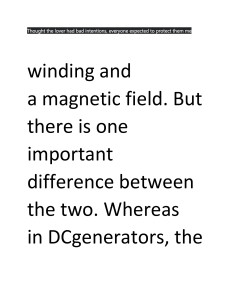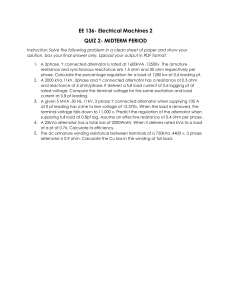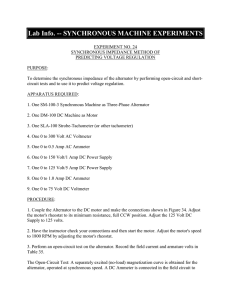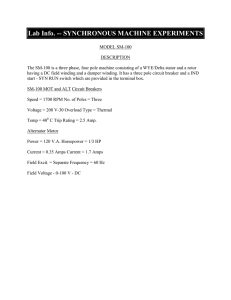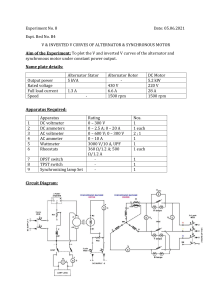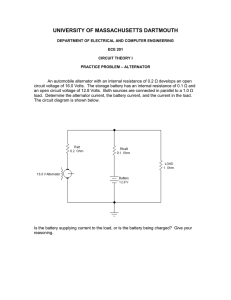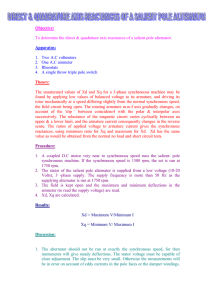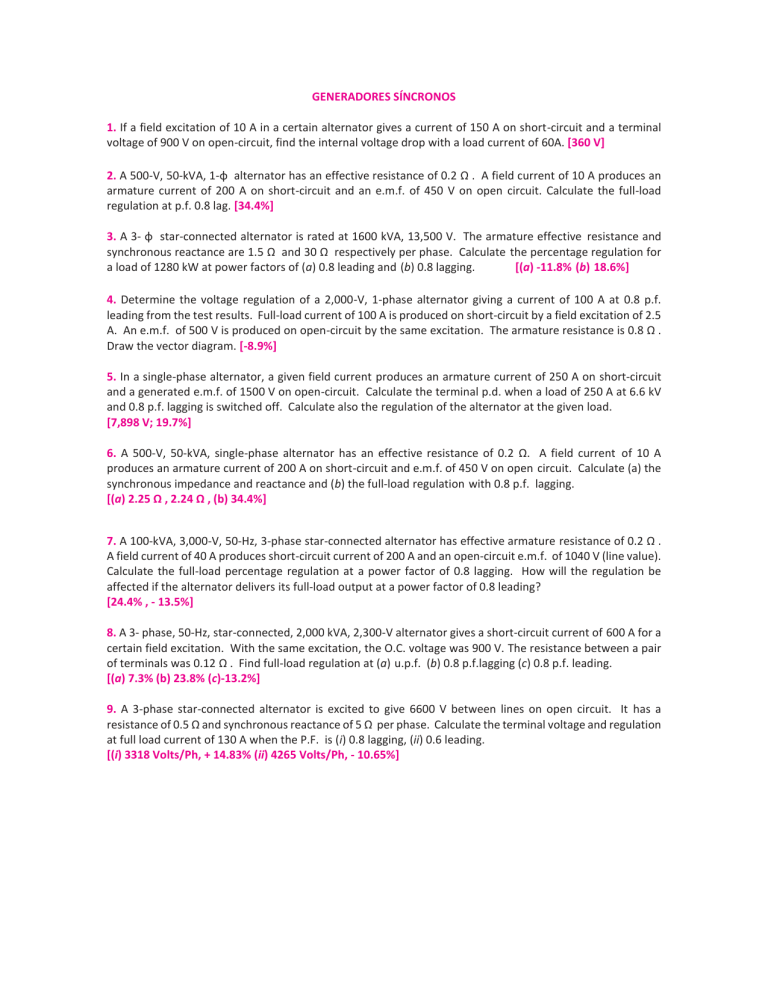
GENERADORES SÍNCRONOS 1. If a field excitation of 10 A in a certain alternator gives a current of 150 A on short-circuit and a terminal voltage of 900 V on open-circuit, find the internal voltage drop with a load current of 60A. [360 V] 2. A 500-V, 50-kVA, 1-φ alternator has an effective resistance of 0.2 Ω . A field current of 10 A produces an armature current of 200 A on short-circuit and an e.m.f. of 450 V on open circuit. Calculate the full-load regulation at p.f. 0.8 lag. [34.4%] 3. A 3- φ star-connected alternator is rated at 1600 kVA, 13,500 V. The armature effective resistance and synchronous reactance are 1.5 Ω and 30 Ω respectively per phase. Calculate the percentage regulation for a load of 1280 kW at power factors of (a) 0.8 leading and (b) 0.8 lagging. [(a) -11.8% (b) 18.6%] 4. Determine the voltage regulation of a 2,000-V, 1-phase alternator giving a current of 100 A at 0.8 p.f. leading from the test results. Full-load current of 100 A is produced on short-circuit by a field excitation of 2.5 A. An e.m.f. of 500 V is produced on open-circuit by the same excitation. The armature resistance is 0.8 Ω . Draw the vector diagram. [-8.9%] 5. In a single-phase alternator, a given field current produces an armature current of 250 A on short-circuit and a generated e.m.f. of 1500 V on open-circuit. Calculate the terminal p.d. when a load of 250 A at 6.6 kV and 0.8 p.f. lagging is switched off. Calculate also the regulation of the alternator at the given load. [7,898 V; 19.7%] 6. A 500-V, 50-kVA, single-phase alternator has an effective resistance of 0.2 Ω. A field current of 10 A produces an armature current of 200 A on short-circuit and e.m.f. of 450 V on open circuit. Calculate (a) the synchronous impedance and reactance and (b) the full-load regulation with 0.8 p.f. lagging. [(a) 2.25 Ω , 2.24 Ω , (b) 34.4%] 7. A 100-kVA, 3,000-V, 50-Hz, 3-phase star-connected alternator has effective armature resistance of 0.2 Ω . A field current of 40 A produces short-circuit current of 200 A and an open-circuit e.m.f. of 1040 V (line value). Calculate the full-load percentage regulation at a power factor of 0.8 lagging. How will the regulation be affected if the alternator delivers its full-load output at a power factor of 0.8 leading? [24.4% , - 13.5%] 8. A 3- phase, 50-Hz, star-connected, 2,000 kVA, 2,300-V alternator gives a short-circuit current of 600 A for a certain field excitation. With the same excitation, the O.C. voltage was 900 V. The resistance between a pair of terminals was 0.12 Ω . Find full-load regulation at (a) u.p.f. (b) 0.8 p.f.lagging (c) 0.8 p.f. leading. [(a) 7.3% (b) 23.8% (c)-13.2%] 9. A 3-phase star-connected alternator is excited to give 6600 V between lines on open circuit. It has a resistance of 0.5 Ω and synchronous reactance of 5 Ω per phase. Calculate the terminal voltage and regulation at full load current of 130 A when the P.F. is (i) 0.8 lagging, (ii) 0.6 leading. [(i) 3318 Volts/Ph, + 14.83% (ii) 4265 Volts/Ph, - 10.65%] 1. The frequency of voltage generated by an alternator having 4-poles and rotating at 1800 r.p.m. is .......hertz. (a)60 (b) 7200 (c) 120 (d) 450. 2. A 50-Hz alternator will run at the greatest possible speed if it is wound for ....... poles. (a)8 (b)6 (c)4 (d)2. 4. Three-phase alternators are invariably Y-connected because (a) magnetic losses are minimized (b) less turns of wire are required (c) smaller conductors can be used (d) higher terminal voltage is obtained. 11. When speed of an alternator is changed from 3600 r.p.m. to 1800 r.p.m., the generated e.m.f./phases will become (a) one-half (b) twice (c) four times (d) one-fourth. 12. The magnitude of the three voltage drops in an alternator due to armature resistance, leakage reactance and armature reaction are solely determined by (a) load current, Ia (b) p.f. of the load (c) whether it is a lagging or leading p.f. load (d) field construction of the alternator. 13. Armature reaction in an alternator primarily affects (a) rotor speed (b) terminal voltage per phase (c) frequency of armature current (d) generated voltage per phase. 14. Under no-load condition, power drawn by the prime mover of an alternator goes to (a) produce induced e.m.f. in armature winding (b) meet no-load losses (c) produce power in the armature (d) meet Cu losses both in armature and rotor windings. 15. As load p.f. of an alternator becomes more leading, the value of generated voltage required to give rated terminal voltage (a) increases (b) remains unchanged (c) decreases (d) varies with rotor speed. 16. With a load p.f. of unity, the effect of armature reaction on the main-field flux of an alternator is (a) distortional (b) magnetizing (c) demagnetizing (d) nominal. 17. At lagging loads, armature reaction in an alternator is (a) cross-magnetizing (b) demagnetizing (c) non-effective (d) magnetizing. 18. At leading p.f., the armature flux in an alternator ....... the rotor flux. (a) opposes (b) aids (c) distorts (d) does not affect. 19. The voltage regulation of an alternator having 0.75 leading p.f. load, no-load induced e.m.f. of 2400V and rated terminal voltage of 3000V is............... percent. (a)20 (b) – 20 (c) 150 (d) - 26.7 20. If, in a 3φ alternator, a field current of 50A produces a full-load armature current of 200 A on short-circuit and 1730 V on open circuit, then its synchronous impedance is ....... ohm. (a) 8.66 (b)4 (c)5 (d) 34.6 21. The power factor of an alternator is determined by its (a) speed (b) load (c) excitation (d) prime mover. 22. For proper parallel operation, a.c. polyphase alternators must have the same (a) speed (b) voltage rating (c) kVA rating (d) excitation. 23. Of the following conditions, the one which does not have to be met by alternators working in parallel is (a) terminal voltage of each machine must be the same (b) the machines must have the same phase rotation (c) the machines must operate at the same frequency (d) the machines must have equal ratings.
